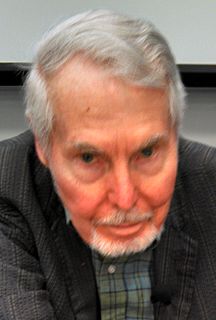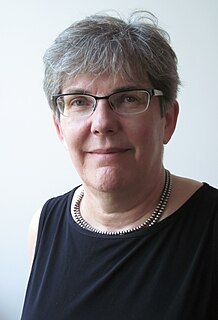Related Research Articles

SLAC National Accelerator Laboratory, originally named Stanford Linear Accelerator Center, is a United States Department of Energy National Laboratory operated by Stanford University under the programmatic direction of the U.S. Department of Energy Office of Science and located in Menlo Park, California. It is the site of the Stanford Linear Accelerator, a 3.2 kilometer (2-mile) linear accelerator constructed in 1966 and shut down in the 2000s, which could accelerate electrons to energies of 50 GeV.

Burton Richter was an American physicist. He led the Stanford Linear Accelerator Center (SLAC) team which co-discovered the J/ψ meson in 1974, alongside the Brookhaven National Laboratory (BNL) team led by Samuel Ting for which they won Nobel Prize for Physics in 1976. This discovery was part of the November Revolution of particle physics. He was the SLAC director from 1984 to 1999.

Melissa Eve Bronwen Franklin is an experimental particle physicist and the Mallinckrodt Professor of Physics at Harvard University. In 1992 Professor Franklin became the first woman to receive tenure in the Physics department at Harvard University and she served as Chair of the department from 2010 to 2014. While working at Fermi National Accelerator Laboratory in Chicago, her team found some of the first evidences for the existence of the top quark. In 1993, Franklin was elected a fellow of the American Physical Society. She is currently member of the CDF (Fermilab) and ATLAS (CERN) collaborations.
Wolfgang Kurt Hermann "Pief" Panofsky, was a German-American physicist who won many awards including the National Medal of Science.

John David Jackson was a Canadian–American physics professor at the University of California, Berkeley and a faculty senior scientist emeritus at Lawrence Berkeley National Laboratory.
Sidney David Drell was an American theoretical physicist and arms control expert.

Persis S. Drell is an American physicist best known for her expertise in the field of particle physics. She was the director of the SLAC National Accelerator Laboratory from 2007 to 2012. She was dean of the Stanford University School of Engineering from 2014 until 2017. Drell became the Provost of Stanford University on February 1, 2017.
The Sackler Prize can indicate any of the following three awards established by Raymond Sackler and his wife Beverly Sackler.
Joachim Stöhr is a physicist and professor emeritus of the Photon Science Department of Stanford University. His research has focused on the development of X-ray and synchrotron radiation techniques and their applications in different scientific fields with emphasis on surface science and magnetism. During his career he also held several scientific leadership positions, such as the director of the Stanford Synchrotron Radiation Laboratory (SSRL) and he was the founding director of the Linac Coherent Light Source (LCLS), the world's first x-ray free electron laser.

Richard Edward Taylor,, was a Canadian physicist and Stanford University professor. He shared the 1990 Nobel Prize in Physics with Jerome Friedman and Henry Kendall "for their pioneering investigations concerning deep inelastic scattering of electrons on protons and bound neutrons, which have been of essential importance for the development of the quark model in particle physics."
H. Pierre Noyes was an American theoretical physicist. He was a member of the faculty at the SLAC National Accelerator Laboratory at Stanford University since 1962. Noyes specialized in several areas of research, including the relativistic few-body problem in nuclear and particle physics.
Elizabeth A. Rauscher (1937-2019) was an American physicist and parapsychologist. She was born in Berkeley, California on March 18, 1937. She died on July 3, 2019.

Philip H. Bucksbaum is an American atomic physicist, the Marguerite Blake Wilbur Professor in Natural Science in the Departments of Physics, Applied Physics, and Photon Science at Stanford University and the SLAC National Accelerator Laboratory. He also directs the Stanford PULSE Institute.
Xiaoliang Qi is a Chinese physicist and professor at Stanford University who studies quantum entanglement, quantum gravity, quantum chaos, and topological phenomena in condensed matter. He earned his B.S. in 2003 and Ph.D. in 2007 from Tsinghua University.
Vera G. Lüth is an experimental particle physicist and professor emerita at Stanford Linear Accelerator Center (SLAC), Stanford University, in the United States. A senator of the Helmholtz Association, she has worked in particle physics at SLAC since 1974. She is a fellow of the American Physical Society.

Heidi Marie Schellman is an American particle physicist at Oregon State University (OSU), where she heads the Department of Physics. She is an expert in Quantum chromodynamics.
J. C. Séamus Davis is an Irish physicist whose research explores the world of macroscopic quantum physics. Davis concentrates upon the fundamental physics of exotic states of electronic, magnetic, atomic and space-time quantum matter. A specialty is development of innovative instrumentation to allow direct atomic-scale visualization or perception of the quantum many-body phenomena that are characteristic of these states.
Martin B. Einhorn is an American theoretical physicist.
Eugene John "Gene" Mele is a professor of physics at the University of Pennsylvania, where he researches quantum electric phenomena in condensed matter.
The SLAC Theory Group is the hub of theoretical particle physics research at the SLAC National Accelerator Laboratory at Stanford University. It is a subdivision of the Elementary Particle Physics (EPP) Division at SLAC.
References
- ↑ "Faculty named to endowed professorships". Princeton University (Press release). 17 May 2017.
- ↑ Day, C. (2009). "Exotic spin textures show up in diverse materials". Physics Today. 32 (4): 4. Bibcode:2009PhT....62d..12D. doi:10.1063/1.3120883. S2CID 137511150.
- ↑ "DOE Physicists at Work - Dr. Zahid Hasan". Office of Scientific and Technical Information. Archived from the original on 3 September 2017.
- 1 2 "M. Zahid Hasan". Physics .
- 1 2 "Physicists find new control knob for the quantum topological world". Physics World. 13 September 2018.
- ↑ ""How X-rays Pushed Topological Matter Research Over the Top" by Lawrence Berkeley National Laboratory". lbl.gov (Press release). Lawrence Berkeley National Laboratory. 14 April 2017.
- ↑ ""M. Zahid Hasan Experimental Investigator in Quantum Materials Award" by Moore foundation", moore.org, Betty and Gordon Moore foundation, Palo Alto, California, 2014
- ↑ "The Aspen Institute". The Aspen Institute. Retrieved 2020-04-24.
- ↑ "New Members Elected (2020): American Academy of Arts and Sciences". Press Release by the American Academy of Arts & Sciences, Cambridge, Massachusetts, USA. Retrieved 2020-04-23.
- ↑ Kelez, Nicholas; Chuang, Yi-De; Smith-Baumann, Alexis; Franck, Keith; Duarte, R.; Lanzara, A.; Hasan, M.Z.; Dessau, D.S.; Chiang, T.C.; Shen, Z.-X.; Hussain, Zahid (2007). "Design of an elliptically bent refocus mirror for the MERLIN beamline at the advanced light source". Nuclear Instruments and Methods in Physics Research Section A: Accelerators, Spectrometers, Detectors and Associated Equipment. 582 (1): 135–137. Bibcode:2007NIMPA.582..135K. doi:10.1016/j.nima.2007.08.092.